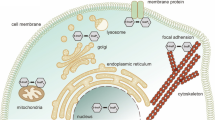Abstract
Inositol phosphate formation was examined in aluminium-treated murine neuroblastoma cells labelled with [3H]-myoinositol. Employing fluoride-stimulated intact cells, aluminium (0.2μM to 1 mM) reduced inositol phosphate formation in a dose-dependent manner. In digitonin-permeabilized cells, stimulated with nonhydrolyzable GTP[S], inositol phosphate formation was also inhibited by increasing aluminium doses; the IC50 value was about 20μM aluminium, while the inositol phosphate level was reduced 2.5 to 3 fold by 50μM aluminium. The inhibitory effect of aluminium (50μM) could not be reversed by increasing GTP[S] concentrations up to 500μM. Prechelation of aluminium to citrate or EGTA completely abolished the aluminium-triggered inhibition of fluoride-stimulated inositol phosphate formation in intact cells, but had little effect on the inhibition of permeabilized cells stimulated with GTP[S]. In neuroblastoma cells phosphoinositide hydrolysis could be evoked either through a pathway involving the Mg2+/guanine nucleotide binding (Gp) protein, or via a pathway operative in the presence of high intracellular Ca2+ concentrations. In the Mg2+/Gp protein-mediated pathway, formation of inositol triphosphate, IP3, inositol diphosphate, IP2, and inositol monophosphate, IP, was apparently inhibited by aluminium in an interdependent manner. As to the Ca2+-mediated pathway, aluminium application mainly diminished the release of IP3. Following interiorization, aluminium thus acts upon elements critical for phosphoinositide-associated signal transduction. An aluminium target apparently resides on the Gp protein. Phosphatidylinositol-4,5-diphosphate-specific phospholipase C probably harbours a second aluminium target.
Similar content being viewed by others
References
van der Voet GB, Marani E, Tio S, de Wolff FA: Aluminium neurotoxicity. Progr Histo-Cytochem 23: 235–242, 1991
Nebeker HG, Coburn JW: Aluminum and renal osteodystrophy. Ann Rev Med 37: 79–95, 1986
Gilman AG: G proteins, transducers of receptor-generated signals. Ann Rev Biochem 56: 615–649, 1987
Johnson GVW, Jope RS: Aluminum impairs glucose utilization and cholinergic activity in rat brainin vitro. Toxicol 40: 93–102, 1986
Jope RS: Modulation of phosphoinositide hydrolysis by NaF and aluminum in rat cortical slices. J Neurochem 51: 1731–1736, 1988
McDonald JJ, Mamrack CM: Aluminum affects phosphoinositide hydrolysis by phosphoinositide C. Biochem Biophys Res Comm 155: 203–208, 1988
Miller JL, Hubbard CM, Litman BJ, Macdonald TL: Inhibition of transducin activation and guanosine triphosphatase activity by aluminum ion. J Biol Chem 264: 243–250, 1989
Schöfl C, Sanchez-Bueno A, Dixon CJ, Woods NM, Lee JAC, Cuthbertson KSR, Cobbold PH, Birchall JD: Aluminium perturbs oscillatory phosphoinositide-mediated calcium signalling in hormone-stimulated hepatocytes. Biochem J 269: 547–550, 1990
Wakui M, Itaya K, Birchall D, Petersen OH: Intracellular aluminum inhibits acetylcholine- and caffeine-evoked Ca2+ mobilization. FEBS Lett 267: 301–304, 1990
Shi B, Haug A: Aluminium interferes with signal transduction in neuroblastoma cells. Pharmacol Toxicol 71: 308–313, 1992
Shi B, Haug A: Aluminum uptake by neuroblastoma cells. J Neurochem 55: 551–558, 1990
Challiss RAJ, Batty IH, Nahorsky SR: Mass measurements of inositol (1,4,5)-triphosphate in rat cerebral cortex slices using a radio-receptor assay: Effects of neurotransmitters and depolarization. Biochem Biophys Res Comm 157: 684–691, 1988
Berridge MJ, Dawson RMC, Downes CP, Heslop JP, Irvine RF: Changes in the levels of inositol phosphates after agonist-dependent hydrolysis of membrane phosphoinositides. Biochem J 212: 473–482, 1983
Wojcikiewicz JH, Fain JN: Polyamines inhibit phospholipase C-catalyzed polyphosphoinositide hydrolysis. Biochem J 255: 1015–1021, 1988
Martin RB: The chemistry of aluminum as related to biology and medicine. Clin Chem 32: 1797–1806, 1986
Karlik SJ, Elgavish GA, Eichhorn GL: Multinuclear NMR studies on Al(III) complexes of ATP and related compounds. J Am Chem Soc 105: 602–609, 1983
Laussac JP, Commenges G:1H,13C,31P, and27A1 NMR study of aluminum-ATP complexes. A possible relation with its biological application. Nouv Chim 7: 579–585, 1983
Guy SP, Seabright P, Itzhaki RF: Uptake of aluminium by human neuroblastoma cells. J Trace Elem Electrolytes Health Dis 4: 183–187, 1990
Simonsson P, Rodriguez FD, Loman N, Alling C: G protein coupled to phospholipase C, molecular targets of long-term ethanol exposure. J Neurochem 56: 2018–2026, 1991
Cockroft LJ, Taylor JA: Fluoroaluminates mimic guanosine 5′-[gamma-thio]triphosphate in activating the polyphosphoinositide phosphodiesterase of hepatocyte membranes. Biochem J 241: 409–414, 1987
Freissmuth M, Casey PJ, Gilman AG: G proteins control diverse pathways of transmembrane signaling. FASEB J 3: 2125–2131, 1989
Schoepp DD: Manganese stimulates the incorporation of [3H]inositol into a pool of phosphatidylinositol in brain that is not coupled to agonist-induced hydrolysis. J Neurochem 45: 1481–1486, 1985
Brammer JB, Hajimohammadreza I, Sardiwal S, Weaver K: Is inositol biphosphate the product of A23187 and carbachol-mediated polyphosphoinositide breakdown in synaptosomes? J Neurochem 51: 514–521, 1988
Perl DP, Good PF: The association of aluminium, Alzheimer's disease and neurofibrillary tangles. J Neural Transm 24: 205–211, 1987
Nixon RA, Clarke JF, Logvinenko KB, Tan MKH, Hoult M, Grynspan F: Aluminum inhibits calpain-mediated proteolysis and induces human neurofilament proteins to form protease-resistant high molecular weight complexes. J Neurochem 55: 1950–1959, 1990
Martell AE, Motekaitis RJ: Coordination chemistry and speciation of Al(III) in aqueous solution. In: TE Lewis (ed.) Environmental Chemistry and Toxicology of Aluminum. Lewis Publ, Boca Raton, FL 1989, pp 3–17
Macdonald TL, Humphreys WG, Martin RB: Promotion of tubulin assembly by aluminum ion. Science 236: 183–186, 1987
Eckstein F: Nucleoside phosphorothioates. Ann Rev Biochem 54: 367–402, 1985
Chandler LJ, Crews FT: Calcium- versus G protein-mediated phosphoinositide hydrolysis in rat cerebral cortical synaptoneurosomes. J Neurochem 55: 1022–1030, 1990
Eberhard A, Holz RW: Calcium promotes the accumulation of polyphosphoinositide in intact and permeabilized bovine adrenal chromaffin cells. Cell Molec Neurobiol 11: 357–379, 1991
Dennis EA: Phospholipases. In: PD Boyer (ed.) The Enzymes. vol 16. Academic Press, Inc., New York, 1983, pp 307–353
Levine SN, Sonnier GB, Abroe K: Effects of diabetes mellitus and aluminum toxicity on myocardial calcium transport. Toxicol 65: 137–148, 1990
Yuan S, Haug A: Frictional resistance to motions of bimane-labelled spinach calmodulin in response to ligand binding. FEBS Lett 234: 218–223, 1988
Birchall JD, Chappell JS: Aluminium, chemical physiology, and Alzheimer's disease. Lancet Oct. 29, ii: 1008–1010, 1989
Author information
Authors and Affiliations
Rights and permissions
About this article
Cite this article
Shi, B., Chou, K. & Haug, A. Aluminium impacts elements of the phosphoinositide signalling pathway in neuroblastoma cells. Mol Cell Biochem 121, 109–118 (1993). https://doi.org/10.1007/BF00925969
Received:
Accepted:
Issue Date:
DOI: https://doi.org/10.1007/BF00925969




